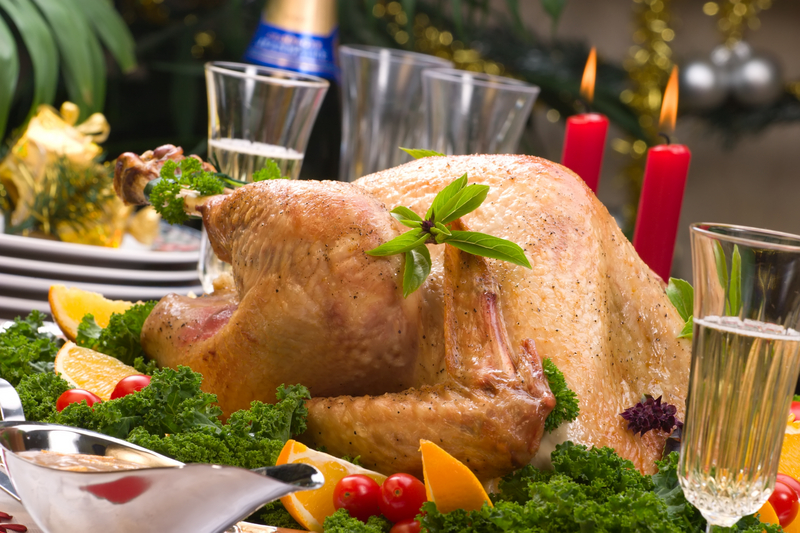Sitting around a table groaning with rich and delicious foods is the traditional way to celebrate Thanksgiving with family and friends. There is less to be thankful for the next morning, when the meal is gone but the overstuffed, bloated feeling remains. While a 2010 study from the National Institute of Child Health and Human Development found that Americans gain only about one pound during the winter holiday season, the study also pointed out that this weight accumulates over the years and is a large contributor to obesity and chronic disease later in life. In addition, the types of foods we eat during the holidays are frequently highly processed and laden with sugar, salt and undesirable fats, all of which contribute to chronic inflammation. On the brighter side, many traditional Thanksgiving foods are actually brimming not only with taste, but with important nutrients. Both the choice of items and the way we mentally approach the season can impact our weight and overall wellness. The key to a happy and healthy holiday is to set realistic goals about which foods to eat and how much to consume.
Festive Foods
The holiday table can be a nutritional powerhouse when the right foods are featured. Make these the centerpiece of the table.
Start with a salad full of green leafy vegetables, topped with a small amount of dressing made with balsamic vinegar and either olive oil or a mild nut oil. Add other colorful vegetables to the salad or as a side dish.
Enjoy the turkey. It is a lean source of good quality protein, just go easy on the gravy.
Try a stuffing or side dish of quinoa, chopped nuts and dried cranberries or apricots. This tasty combination is rich in protein, antioxidants, fiber and vitamins.
A dish of baked winter squash with walnuts or pecans contains fiber, minerals and omega-3 fats. These foods are anti-inflammatory and support normal immune function.
Broccoli, Cauliflower, and Brussels sprouts are delicious roasted with olive oil, garlic and salt. They protect against germs and help the body detoxify.
Mashed sweet potatoes are full of beta carotene for good vision and good immune function.
If you need a snack, choose handful of pecans, walnuts, hazelnuts, pumpkin seeds etc.
Be mindful of sugar intake. Sugar causes increased inflammation and blood sugar surges. Use sweeteners in moderation. When you do need some sweetness try raw honey, which not only contains B Vitamins, but also fights bacteria.
Although alcohol is not essential for fun, if spirits are included in your holiday plan, antioxidant rich red wine is a good choice. Fruity sangria is another option, as is a Bloody Mary – be sure to eat the celery stick!
Avoid trans fats. Use fats found in nature for cooking and baking. Moderate amounts of butter, olive oil, nut and seed oils, avocado and coconut oil are the optimal choices for wellness.
Savvy Strategies
Be extra careful to avoid foods you are sensitive to: Dairy, gluten and nightshade vegetables (i.e. potatoes, tomatoes, and eggplant) are a few of the foods that are known to be inflammatory. If you are reactive to these foods, bring your own safe alternatives if you can’t be sure safe options will be available.
Eat the most nutritious foods first: Hors d’oeuvres made with cheeses, pastry crusts, and processed fats can be bite size bombs of empty calories. On the other hand, appetizers such as fresh vegetables and hummus, fruit, nuts, and shrimp are nutrient rich meal starters. Eating these first will leave less room for other less desirable options.
Journal it: Keeping a food diary is a well-known strategy for weight management any time of year, but is especially helpful during the holiday season, when a bit of this and a bite of that adds up quickly. Once written down, extra desserts and neglected veggies are harder to overlook.
Pack snacks: Keeping healthy snacks handy in an office drawer, car or purse helps you resist the temptation to grab every treat that passes by.
Be realistic: Holidays are not the time to swear off desserts or start a diet. A more successful approach is to commit to one treat a day and choose it carefully. Promise yourself that the nourishing foods will still be the bulk of your intake and plan accordingly.
Manage portion size: We are programmed to eat what is in front of us, so use a salad plate and juice glass for food and beverages, instead of dinner plate. Pledge to eat only one plate full and carefully choose the foods to put on the plate.
Add Activity: Autumn in New England is a perfect time to get outside and enjoy the foliage. Instead of sitting around the table after a meal, suggest a family walk, or organize a game on the lawn. Be sure to plan your activity as carefully as you plan your meals, and write it in the journal.
Stay calm: The increased demands on our time, along with complex family dynamics, can turn any holiday into a stress-fest, which increases inflammation. Along with planning food and exercise, be sure to include stress-busting activities.
Holidays do not have to be a time of overindulgence, gluttony and regret. Instead, by planning in advance and making wise choices, the season can be filled with good food, good friends and family, and great memories.
Vicki Kobliner MS RD, CD-N is a Registered Dietitian and owner of Holcare Nutrition (www.holcarenutrition.com). Vicki works with infants, children and adults with digestive disorders, food allergies, ADHD, autism and other chronic illness, and provides fertility and prenatal nutrition counseling. Vicki has extensive experience in using dietary modification, appropriate supplementation and functional lab testing to achieve optimal wellness. She can be reached at 203.834.9949 or [email protected].
